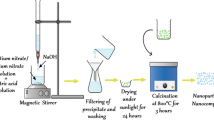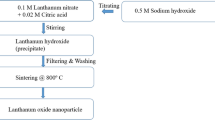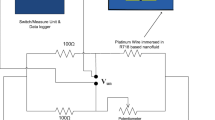Abstract
Heat transfer fluids such as therminol have long been utilized in a range of applications. Increasing the thermophysical properties of therminol is one of the promising strategies to improve the performance of therminol-based systems and overcome the disadvantages of poor thermal performance. Nanofluids transport heat more effectively than ordinary conventional fluids. The goal of this work is to evaluate the influence of lanthanum oxide-strontium oxide (LaO-SrO) nanocomposite on the thermal conductivity and viscosity of therminol experimentally. The chemical co-precipitation approach was used to synthesis the LaO-SrO nanocomposite. X-ray diffraction (XRD) and UV-Visible spectroscopy were used to evaluate the structural and optical characteristics of the nano samples. LaO-SrO based nanofluid was prepared with therminol as the base fluid. Thermal conductivity studies of LaO-SrO nanofluids were carried out in detail at different weight percentages of LaO-SrO nanocomposite at varying temperatures. The nanofluid exhibit an increase in thermal conductivity and viscosity as compared with base fluid therminol. The viscosity shows a significant decrease as the temperature rises from 25°C to 50°C. Results show that LaO-SrO nanofluids can be used as a better alternative for conventional fluids in heat transfer applications.












Similar content being viewed by others
References
Wei B, Zou C and Li X 2017 Experimental investigation on stability and thermal conductivity of diathermic oil-based TiO2 nanofluids. Int. J. Heat Mass Transf. 104: 537–543
Naresh Y, Dhivya A, Suganthi K S and Rajan K S 2012 High-temperature thermophysical properties of novel CuO-therminol 55 nanofluids. Nanosci. Nanotechnol. Lett. 12: 1209–1213
Fazlay, Das L, Habib K, Aslfattahi N, Saidur R and Ul S 2021 A comprehensive review on advances of oil-based nanofluids for concentrating solar thermal collector application. J. Mol. Liq. 116771
Gulzar O, Qayoum A and Gupta R 2018 Photothermal characteristics of hybrid nanofluids based on Therminol-55 oil for concentrating solar collectors. Appl. Nanosci. 5: 1133–1143
Gulzar O, Qayoum A and Gupta R 2019 Experimental study on stability and rheological behaviour of hybrid Al2O3-TiO2 Therminol-55 nanofluids for concentrating solar collectors. Powder Technol. 352: 436–444
Mehrali M 2014 Preparation characterization viscosity and thermal conductivity of nitrogen-doped graphene aqueous nanofluids. J. Mater. Sci. 20: 7156–7171
Kazemi I, Sefid M and Afrand M 2020 Improving the thermal conductivity of water by adding mono & hybrid nano-additives containing graphene and silica: a comparative experimental study. Int. Commun. Heat Mass Transf. 104648: 1–13
Li Y, Tung S, Schneider E and Xi S 2009 A review on the development of nanofluid preparation and characterization. Powder Technology 196(2): 89–101
Eshgarf H, Kalbasi R, Maleki A, Shadloo M S and Karimipour A 2020 A review on the properties, preparation, models, and stability of hybrid nanofluids to optimize energy consumption. J. Therm. Anal. Calorim. 0123456789
Okonkwo Eric C, Wole-Osho Ifeoluwa, Almanassra Ismail W, Abdullatif Yasser M and Al-Ansari Tareq 2021 An updated review of nanofluids in various heat transfer devices. Journal of Thermal Analysis and Calorimetry 145: 2817–2872
Huminic, Angel, Gabriela Huminic, Claudiu Fleaca, Florian Dumitrache and Ion Morjan 2019 Thermo-physical properties of water-based lanthanum oxide nanofluid. An experimental study. Journal of Molecular Liquids. 287: 111013
Akhgar Alireza, Toghraie Davood, Sina Nima and Afrand Masoud 2019 Developing dissimilar artificial neural networks (ANNs) to prediction the thermal conductivity of MWCNT-TiO2/Water-ethylene glycol hybrid nanofluid. Powder Technology 355: 602–610
Wang Kunjie, Yanping Wu, Li Hongxia, Li Mingliang, Guan Feng and Fan Haiyan 2014 A hybrid antioxidizing and antibacterial material based on Ag–La2O3 nanocomposites. Journal of Inorganic Biochemistry. 141: 36–42
Sulaiman N, Yoki Yulizar and Apriandanu 2018 Eco-friendly method for synthesis of La2O3 nanoparticles using Physalis angulata leaf extract. In: AIP Conference Proceedings. 2023: 020105
Thutug Rahardiant Primadi, Aman Santoso and Fauziatul Fajaroh 2020 The Effect of SrO Impregnation on The Characteristics of Cobalt Ferrite (CoFe2O4) Nanoparticles Synthesized by Co-precipitation IOP Conf. Series: Materials Science and Engineering 833: 012086
Mohammed M Rahman, Mohammad Musarraf Hussainab and Abdullah M Asiri 2016 A novel approach towards hydrazine sensor development using SrO$CNT nanocomposites RSC Adv. 6: 65338–65348
Athar Taimur 2013 Synthesis and Characterization of Strontium Oxide Nanoparticles via Wet Process. Materials Focus. 2: 450–453
Noori A M, Yavari R, Baharvandi H and Alizade A 2018 Evaluation of different parameters on production of Zr 2 Cu by mechanical alloying. Silicon. 10: 1161–1169
Valerio A, Morelhao S L 2019 Usage of Scherrer's formula in X-ray diffraction analysis of size distribution in systems of monocrystalline nanoparticles. arXiv preprint arXiv:1911.00701
Sathishkumar A S, Arun Balasubramanian K and Ramkumar T 2020 Structural characterization of ZnO, CuO and Fe2O3 nanoparticles: evaluation of rietveld refinement. Tierarztl. Prax. 40: 1139–1154
Madhavi J 2019 Comparison of average crystallite size by X-ray peak broadening and Williamson-Hall and size–strain plots for VO2+ doped ZnS/CdS composite nanopowder. S N Applied Sciences. 1(11): 1509
Choudhury B, Dey M and Choudhury A 2013 Defect generation, d-d transition, and band gap reduction in Cu-doped TiO2 nanoparticles. International Nano Letters. 3: 1–8
Rahman, Mohammed M, Mohammad Musarraf Hussain and Abdullah M Asiri 2016 A novel approach towards hydrazine sensor development using SrO· CNT nanocomposites." RSC advances. 70: 65338–65348
Biju R, Ravikumar R, Thomas Christopher and Indulal C R 2022 Enhanced photocatalytic degradation of Metanil Yellow dye using polypyrrole-based copper oxide–zinc oxide nanocomposites under visible light. Journal of Nanoparticle Research. 6: 1–16
Saidur R, Leong K Y and Mohammed H A 2011 A review on applications and challenges of nanofluids. Renew. Sustain. Energy Rev. 15: 1646–1668
Gallego A, Cacua K, Herrera B, Cabaleiro D, Pineiro M M and Lugo L 2020 Experimental evaluation of the effect in the stability and thermophysical properties of water-Al2O3 based nanofluids using SDBS as dispersant agent. Adv. Powder Technol. 31: 560–570
Ilyas S U, Ridha S and Abdul Kareem F A 2020 Dispersion stability and surface tension of SDS Stabilized saline nanofluids with Graphene nanoplatelets. Colloids Surfaces A Physicochem. Eng. Asp. 592: 124584
Issa R J 2016 Effect of nanoparticles size and concentration on thermal and rheological properties of Al2O3-water nanofluids. In: Proc. World Congr. Momentum, Heat Mass Transf.
Chamsa-ard W, Brundavanam S, Fung C C, Fawcett D D and Poinern G 2017 Nanofluid types, their synthesis, properties and incorporation in direct solar thermal collectors: a review. Nanomaterials 7: 7060131
Radkar R, Bhanvase B A, Barai D P and Sonawane S H 2019 Intensified convective heat transfer using ZnO nanofluids in a heat exchanger with helically coiled geometry at constant wall temperature. Mater. Sci. Energy Technol. 2: 161–170
Keblinski P, Phillpot S, Choi S and Eastman J 2002 Mechanisms of heat flow in suspensions of nano-sized particles (nanofluids) Int. J. Heat Mass Transfer. 45: 855–863
Li Y, Tung S, Schneider E and Xi S 2009 A review on the development of nanofluid preparation and characterization. Powder Technol. 196: 89–101
Jang S P and Choi S U 2004 Role of Brownian motion in the enhanced thermal conductivity of nanofluids. Appl. Phys. Lett. 84: 4316
Ghozatloo A, Shariaty Niasar M and Rashidi A M 2013 Preparation of nanofluids from functionalized Graphene by new alkaline method and study on the thermal conductivity and stability. Int. Commun. Heat Mass Transf. 42: 89–94
Manikandan S and Rajan K S 2015 MgO-Therminol 55 nanofluids for efficient energy management: Analysis of transient heat transfer performance. Energy 88: 408–416
Krishnakumar T S, Sheeba A, Mahesh V and Prakash M J 2019 Heat transfer studies on ethylene glycol/water nanofluid containing TiO2 nanoparticles. Int. J. Refrig. 102: 55–61
Kole M and Dey T K 2013 Investigation of thermal conductivity, viscosity, and electrical conductivity of graphene-based nanofluids. J. Appl. Phys. 113: 8
Mariano A, Pastoriza-Gallego M J, Lugo L, Mussari L and Pineiro M M 2015 Co3O4 ethylene glycol-based nanofluids: Thermal conductivity, viscosity, and high-pressure density. Int. J. Heat Mass Transf. 85: 54–60
Acknowledgements
The authors thankfully appreciate the hard work and patience of the staff of the Centre for Materials for Electronics Technology (CMET), Thrissur and Karunya University, Coimbatore.
Funding
The authors declare no specific funding for this work.
Author information
Authors and Affiliations
Contributions
*RR: Conceptualization, Investigation, Methodology, Resources, Original draft- writing & editing. *GMJH: Investigation, Methodology, Resources. *LB: Conceptualization, Investigation, Methodology, Resources, Original draft- writing & editing. *RR: Methodology, Resources, *TSK: Conceptualization, Investigation, Methodology, Resources, Original draft- writing & editing. *CRI: Conceptualization, Investigation, Methodology, Resources, Original draft- writing & editing.
Corresponding author
Ethics declarations
Conflict of interest
The authors have no conflict of interest to declare.
Rights and permissions
Springer Nature or its licensor (e.g. a society or other partner) holds exclusive rights to this article under a publishing agreement with the author(s) or other rightsholder(s); author self-archiving of the accepted manuscript version of this article is solely governed by the terms of such publishing agreement and applicable law.
About this article
Cite this article
Ravikumar, R., Herbert, G.M.J., Binoy, L. et al. Experimental investigations on the thermal properties of rare earth-metal oxide based therminol nano fluids for heat transfer applications. Sādhanā 48, 62 (2023). https://doi.org/10.1007/s12046-023-02122-2
Received:
Revised:
Accepted:
Published:
DOI: https://doi.org/10.1007/s12046-023-02122-2




